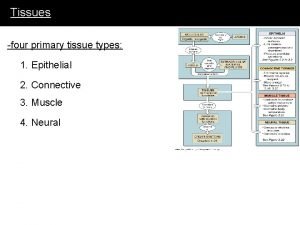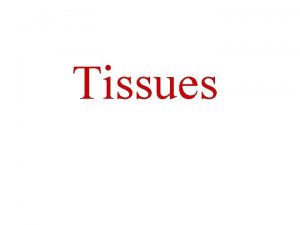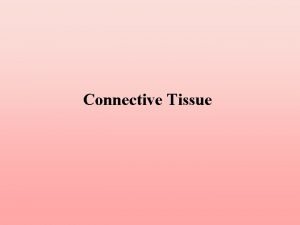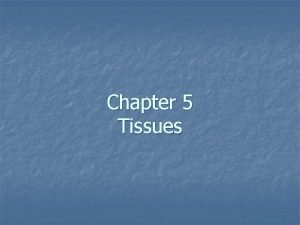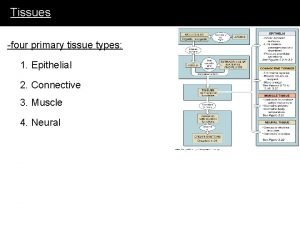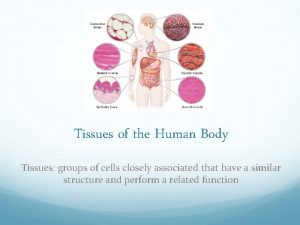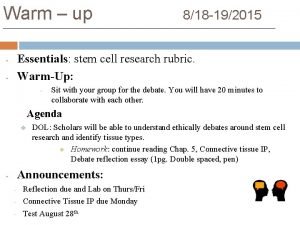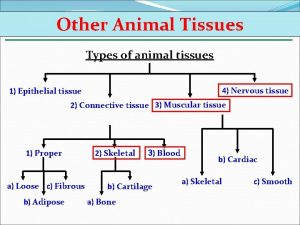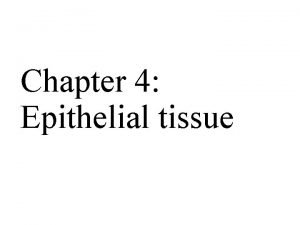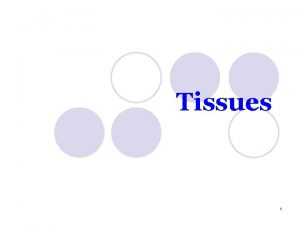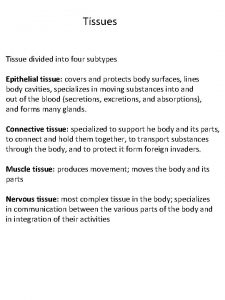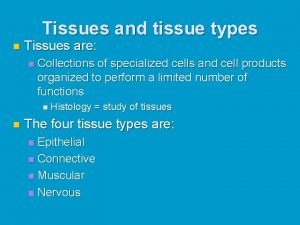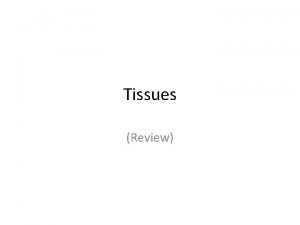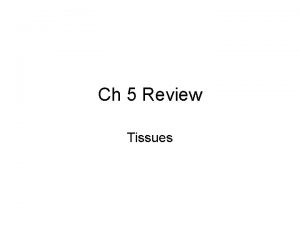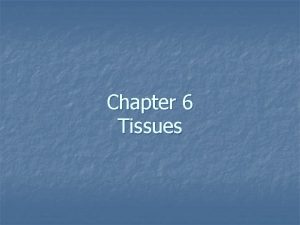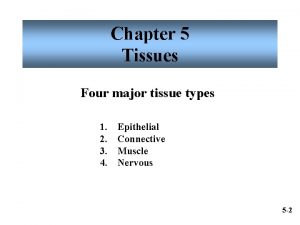Chapter 4 Tissues Review the four tissue types















- Slides: 15

• Chapter 4: Tissues • Review the four tissue types: EMCN • Review the three tissue membranes • Cancer (combines parts of Chapter 3 and Chapter 4) Martini et al. (2018), Figure 3. 1 1

Chapter 4: Test Question Templates By the end of this chapter, you should be able to answer questions such as… • Q 1. Given a bodily function, identify which of the four general tissue types is the main executor of that function and which organelles are important in carrying out that function. • Example A: secretion of protein hormones. • Example B: destroying pathogens like viruses and bacteria. • Q 2. Given a specific tissue, estimate that tissue’s relative risk for cancer (high, medium, low) based on (A) the frequency with which those cells normally divide and (B) the typical exposure of those cells to chemical or physical “insults” that might increase the rate of cell division and/or the likelihood of a genetic mutation. • Example A: neurons in your brain. • Example B: simple columnar epithelium lining your digestive tract.

Chapter 4 prelude: How is thinking about tissues different from thinking about individual cells? At least 3 ways. Moving from the cell level to the tissue level, the following 3 issues become more prominent: • Physical connections between cells (gap junctions, tight junctions, etc. ) • Extracellular matrix illustrated well by this figure (outside cells) of areolar connective tissue • Multiple cell types Marieb & Hoehn (2019), Figure 4. 9 3

Overview of the 4 basic tissue types (label the categories!) Name Function Protect borders, exchange with environment Connects other tissues, transport, protection, support Contract, exert Quickly force transmit electrical signals Unique structural features Polarity, microvilli, cilia, close connections between cells, avascular (no blood vessels) Lots of extracellular space, extracellular proteins, relatively sparse cells Intracellular contractile proteins slide past each other Neurons + glial cells, both with long cellular processes (dendrites, axons) 4

The 4 main tissue types: epithelial • Q 1. By which 2 structural criteria are epithelial tissues classified into subcategories? • Q 2. In terms of function… • (A) Which epithelial subtypes are best for protecting underlying tissues? • (B) Which are best for exchanging substances with the external or internal environment? 5

How epithelial tissues’ structures relate to functions, continued An epithelial tissue function: form a hard-topenetrate lining or boundary. Q 1. What structures serve this function by keeping adjacent epithelial cells connected to each other and preventing things from passing between them? Q 2. What additional structure, NOT pictured here, connects adjacent cells and allows small molecules to pass between them? Martini et al. (2018), Figure 2. 14 6

Connective Tissue Classification • Your Human Anatomy textbook (Martini et al. ) considered cartilage and bone to be “supporting connective tissue, ” and blood and lymph to be “fluid connective tissue. ” • If not epithelial, muscle, or nervous, it must be connective! Marieb & Hoehn (2019), Figure 4. 10 7

Muscle tissue: 3 kinds… Q 1. Label the subtypes above. Q 2. Why do some of these appear striated (striped)? Q 3. Which of these subtypes can all contract as a single unit? Q 4. What structural feature of these cells enables the Q 3 function? Freeman et al. (2015), Table 48. 1 8

Nervous tissue: 2 types of cells (neurons & glial cells) Q 1. In what order do the structures of a neuron typically transmit information? beyondthedish. wordpress. com/2013/11/22/ 9

Summary/review: tissue yoga! To make your body an EPITHELIAL cell… To make your body a MUSCLE cell… To make your body a CONNECTIVE cell… To make your body a NERVOUS cell… Optional: do these poses while listening to/singing the song “E. M. C. N. ” (https: //faculty. washington. edu/crowther/Misc/Songs/EMCN. shtml ) Images: byjus. com 10

Three tissue membranes (multicellular; much larger than cell membranes!) Q 1. Which of these is/are exposed to things from the external environment? Q 2. Which of these is/are moist? Marieb & Hoehn (2019), Figure 4. 14 11

The cell cycle & cancer Q 1. What is the purpose of the cell cycle? Q 2. How is the cell cycle altered in cancer cells? Q 3. Which tissues get the most exposure to mutagens (things that cause genetic mutations)? Marieb & Hoehn (2019), Figure 3. 27 12

Tissue types and cancer Q 1. In general, which of the 4 tissue types requires cells to divide most frequently? (Which cells are constantly being worn out? ) Q 2. It has been estimated that 80 -90% of all cancers are carcinomas (from epithelial tissue), as opposed to, say, sarcomas (from connective or muscle tissue). Is this 80 -90% statistic surprising, in light of your answer to the previous questions and what you know about the cell cycle? Why or why not? Image: http: //yousigma. com/health/cancer. html 13

Chapter 4: Additional resources • Song by previous Bio 232 students about the cell cycle and cancer: “It’s the Treatment I Want!” • https: //faculty. washington. edu/crowther/Misc/Bio. Art/ • Here again is that link to the HHMI Biointeractive “clickand-learn” about the cell cycle and cancer: • www. biointeractive. org/classroom-resources/eukaryotic-cellcycle-and-cancer • Other suggestions? Let me know! 14

Answer key for Suggested Lecture Outline file • You should already have access to answers to some of the questions (Check Your Understanding, online Practice Quiz, online Practice Test) • Answers to pre-lecture questions and end-of-chapter Review Questions will be in the Presenter Notes that accompany this slide. 15
 Body tissues chapter 3 cells and tissues
Body tissues chapter 3 cells and tissues Chapter 3 cells and tissues body tissues
Chapter 3 cells and tissues body tissues Body tissues chapter 3 cells and tissues
Body tissues chapter 3 cells and tissues Body tissues chapter 3 cells and tissues
Body tissues chapter 3 cells and tissues Eisonophil
Eisonophil Cutaneous membrane
Cutaneous membrane What are the four major tissue types
What are the four major tissue types Four basic tissues
Four basic tissues Histology smooth muscle
Histology smooth muscle Chapter 5 tissues
Chapter 5 tissues Simple cuboidal epithelium
Simple cuboidal epithelium Animal tissue
Animal tissue Function of elastic connective tissue
Function of elastic connective tissue Types of tissues
Types of tissues Types of tissues
Types of tissues Zonula occludens
Zonula occludens





